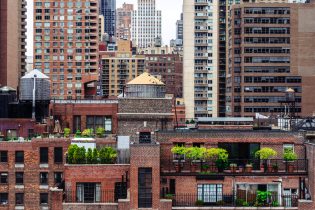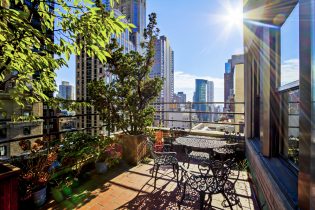Terrace vs. Balcony: Guide to Outdoor Space in NYC

If you are looking to buy an apartment in NYC, you may want to understand the different types of residential outdoor spaces on offer, and what that means for your home search. On this page, we will discuss the differences between a terrace vs. balcony vs. veranda, as well as other common outdoor spaces you may encounter in the New York City real estate market.
Table of Contents
Private Outdoor Spaces—Terrace vs. Balcony vs. Veranda
There are several types of private outdoor spaces you may see described on apartment and house listing in NYC. Here is a list of the most popular ones–terraces, balconies, and verandas–as well as their benefits and drawbacks.
Terraces
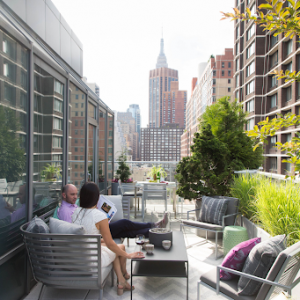
Terraces are usually open, large, outdoor spaces found along the tops and sides of buildings. They can typically be accessed through more than one room or door. While rooftop terraces are popular communal outdoor spaces, there are also terraces that are only shared few units in an apartment building. And of course, the most coveted terrace is a private one only accessible to you and your household.
Unlike balconies, terraces can be recessed into the building as opposed to jutting out from the side. The former can also be partially enclosed, while terraces are always open to the sun.
- Pros: Large and great from hosting guests, multiple points of entry
- Cons: often more expensive and difficult to find than balconies
Balconies

Balconies are enclosed, elevated platforms that usually project out from a single room on an upper floor of a building. Balconies are one of the more common outdoor spaces you can find in New York City apartment buildings, since they are great ways to give apartment dwellers access to fresh air without having to leave their home.
Since balconies tend to attach to a single room, they are usually not shared by multiple apartment units. However, this does not mean that all balconies will give you a sense of privacy. That will largely depend on the orientation, height, and location of your particular balcony.
For example, if your apartment’s balcony is on the second floor and facing a busy street, then you are going to encounter more noise and prying eyes than you would on a on a higher floor, a quiet street, or the back or sides of the building.
Additionally, some balconies may be sheltered, and others may be open air, without a roof. Take the amount of sun you want into consideration when looking at apartments with balconies. Balconies tend to be smaller than terraces.
- Pros: Usually private to a single apartment, no need to leave your apartment to go outside
- Cons: The quality of your balcony depends on many factors and may vary from unit to unit in the same building, can be on the smaller side
Verandas
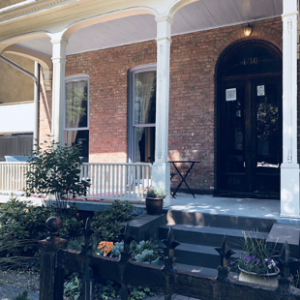
Verandas, also called porches, are generally raised, ground floor platforms on the front or sides of buildings. They are often covered and partially enclosed by fencing, and they function as extensions of your front entrance. Particularly common in the southern United States, you can find these charming outdoor spaces on houses in the five boroughs as well.
Verandas are perfect for relaxing in the shade and taking in the neighborhood or entertaining a few friends on summer nights. However, since they are on the ground floor, they do not offer the privacy or security of some other outdoor spaces. Back porches/verandas are more private than their entryway counterparts, and if they are uncovered, they may also be referred to as “decks.”
- Pros: Sheltered nature provides protection from the sun, aesthetically pleasing
- Cons: Always on the ground floor, not as private as balconies and terraces
Multi-family Outdoor Spaces—Gardens vs Courtyards vs. Roof Access
Unlike private balconies, verandas, and terraces, these spaces are often shared by multiple apartment units or even the whole building. These can be great resources for you and your household, without the time and expense you need to put into keeping up a private outdoor spaces.
Gardens
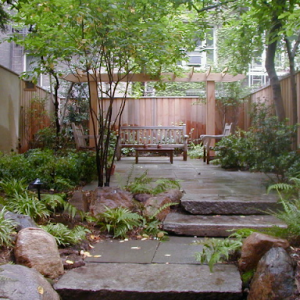
Shared Gardens are great for those New Yorkers with green thumbs. Often featuring green areas, grass, and ornamental plants, some gardens even have plots or garden boxes that residents can use to grow their own vegetables, herbs, and flowers. These garden plots are usually highly sought after, but they can be a wonderful, close-to-home alternative to your local community garden if you are lucky enough to snag one.
- Pros: Opportunities to grow your own plants, beautiful greenery
- Cons: Can be a lot of upkeep depending on your building’s rules, often difficult to get a coveted garden plot
Courtyards
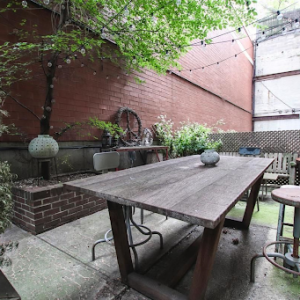
Much like shared gardens, courtyards are accessible to residents of the building or building complex, Unlike gardens, they feature more tile, brick, and concrete than greenery. Courtyards can include amenities like benches, picnic tables, and community areas. You can find public courtyards on the ground floor, both on the front of buildings and in the back. They are usually open air and not enclosed or shaded.
- Pros: Usually large, easily accessible for big gatherings
- Cons: Not private, can sometimes lack green space
Rooftop Terraces
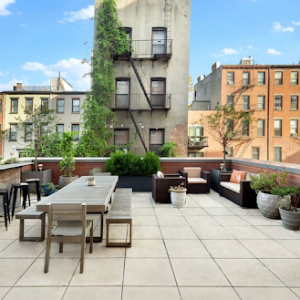
All roofs in New York City are not made the same. Some are unfinished and not accessible to residents, while others function as full-fledged community spaces. These rooftop terraces often have seating, open space, tables, and views of the surrounding city. Some even have grills that residents can enjoy with their friends and neighbors. Depending on your apartment’s policy, dogs can relax and play on patches of rooftop grass or hang out at your feet while you enjoy cold drinks and look out over the city.
- Pros: Can come with great views, usually a large space
- Cons: Not private, views may vary based on the location and height of the building
What These Different Outdoor Spaces Mean for Your Apartment Search
There are many factors to consider when searching for a new apartment, and outdoor space is just one of them. Understanding how terraces, balconies, verandas, gardens, courtyards, and rooftops impact the value of an apartment can help to better inform your apartment search.
Is Outdoor Space Right for You?
Now that you have a better grasp of the kinds of outdoor spaces you may see on apartment listings, you may be wondering if the cost of a terrace, balcony, or veranda is really worth it for you and your household. After all, they can be expensive and do require additional upkeep and cleaning, since they are exposed to the weather and can gather dust and debris. But for many, the benefits far outweigh the drawbacks. A Keller Williams real estate agent can walk you through everything you need to consider before buying a home with an outdoor residential space.
Do Outdoor Spaces Count in Square Footage?
Typically, for space to count towards the square footage of your home, it needs to be “finished” or livable. This means that most outdoor spaces will not count towards your square footage unless they are enclosed and heated. However, just because your balcony or terrace does not add to your square footage does not mean it will not add to the apartments’s value.
Do Outdoor Spaces Impact Your Apartment’s Value?
Outdoor spaces will absolutely have a positive impact on your home’s value. Apartments with outdoor access are rare and highly sought after. The amount of value that an outdoor space can add to your apartment will vary based on many factors, such as:
- The square footage
- The location
- The privacy/exclusivity
- The overall quality
In general, you can estimate that the value of the outdoor space per square foot will be something around half of the value of the apartment’s indoor square footage. A Keller Williams real estate agent can give you a better idea of the costs for outdoor spaces after discussing you and your family’s needs.
Deciding Which Outdoor Space is Right for You
In order to decide what type of outdoor space is right for you, try making out a pro and con list that takes into account your priorities and desires. If you like gardening or outdoor entertaining, then the added cost and upkeep that comes with a large terrace will be more worth it to you than if you only want to occasionally get some fresh air. Balance what you need with what would be simply nice to have, and get an idea of how that fits with your budget by consulting an agent who can walk you through your options.
Want to Learn More About Terraces vs. Balconies?
Hopefully this page has been helpful in clearing up your questions about residential outdoor space in New York City. With this information, you can start thinking seriously about which kind of outdoor space is best for you and your family. Since apartments with outdoor space are often quick to sell on the market, the sooner you start your search, the better.
Reach out to a NewDevRev real estate expert to help you find available properties featuring terraces, balconies, verandas, and more!
- Categories:
